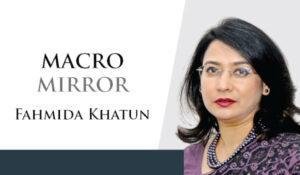Originally posted in The Daily Star on 15 October 2025
 This year’s Nobel Prize in economics went to Joel Mokyr, Philippe Aghion, and Peter Howitt for explaining how innovation creates sustained prosperity. It is a prize for a particular way of seeing growth: as a restless, experimental process that constantly replaces old technologies, firms, and even mindsets with better ones. The Royal Swedish Academy of Sciences honoured the trio “for having explained innovation-driven economic growth,” with half the prize awarded to Mokyr “for having identified the prerequisites for sustained growth through technological progress,” and the other half to Aghion and Howitt “for the theory of sustained growth through creative destruction.”
This year’s Nobel Prize in economics went to Joel Mokyr, Philippe Aghion, and Peter Howitt for explaining how innovation creates sustained prosperity. It is a prize for a particular way of seeing growth: as a restless, experimental process that constantly replaces old technologies, firms, and even mindsets with better ones. The Royal Swedish Academy of Sciences honoured the trio “for having explained innovation-driven economic growth,” with half the prize awarded to Mokyr “for having identified the prerequisites for sustained growth through technological progress,” and the other half to Aghion and Howitt “for the theory of sustained growth through creative destruction.”
At its core, their combined contribution is putting dynamism at the heart of economics. Joel Mokyr demonstrates how a culture that prized useful knowledge and tolerated disruption transformed scientific insight into practical technologies, while Aghion and Howitt provide the mathematical foundation for this story: a model in which new ideas displace incumbent technologies, thereby increasing productivity over time, even as they unsettle the status quo. The press release and scientific background from the Nobel committee make the complementarity of their work plain: Mokyr explains the historical turning point that made continuous improvement possible; Aghion and Howitt show how, once that engine is running, competition, incentives, and policy shape its speed and direction.

Mokyr, in his seminal books The Lever of Riches (1990), The Gifts of Athena (2002), and A Culture of Growth (2016), argues that Europe’s Industrial Revolution did not happen by chance or because of coal or colonial wealth. Rather, it was the result of what he calls an “Industrial Enlightenment”—a period when people began to value practical, useful knowledge. This included both scientific understanding (theory) and hands-on skills (know-how). The two began to reinforce each other: science inspired better tools and machines, while the problems faced by inventors and craftsmen inspired new scientific discoveries. Once this continuous exchange began, innovation became self-sustaining. Mokyr shows that, in earlier times, bursts of creativity faded because societies lacked institutions that encouraged experimentation and accepted failure.
Aghion and Howitt, on the other hand, took Joseph Schumpeter’s evocative phrase “creative destruction” and made it operational. Schumpeter was one of the most influential economists of the early 20th century. Aghion and Howitt’s 1992 Econometrica paper, “A Model of Growth Through Creative Destruction,” formalises an economy where firms climb a quality ladder by innovating, and every innovation replaces the old one, taking business away from existing firms. Growth, therefore, arises within the economy itself, driven by the motivation to stay ahead and earn profits from new ideas. But this process involves a delicate balance. If policymakers protect established firms too much, they discourage new ideas and competition. On the other hand, if inventors are not protected enough, they lose the incentive to invest in innovation.
The Nobel Committee’s background paper explains the basic idea of their model. Economic growth happens through gradual, step-by-step improvements in technology. Innovators get temporary rewards, such as patents, for their discoveries. The overall economic growth depends on how effectively resources like labour and capital move from old technologies to new ones. Over time, this framework has been expanded to study many modern issues, including competition policy, trade, taxation, and inequality, and to design social protection systems for workers losing jobs to technological change.
Furthermore, the “creative destruction” model helped economists examine growth in the real world. The model shows that innovation and competition are closely linked. When companies compete to produce better ideas or products, productivity and living standards rise. This theory has helped researchers understand how competition, trade, research, and development-friendly policies can boost long-term growth while shaping debates about how much governments should support innovation through tax incentives or subsidies, and how workers, hurt by technological change, can be helped. In short, their work connects the world of ideas and invention to the everyday concerns of jobs, inequality, and economic opportunity.
Meanwhile, Mokyr’s historical work shows that economic growth depends both on new inventions and the way knowledge spreads across society. In his view, progress accelerates when countries build strong institutions such as schools, workshops, and research networks that help share ideas and transform them into practical technologies. He highlights the importance of “useful knowledge,” which means combining scientific understanding with the skills needed to apply it. By creating a culture that values learning, curiosity, and problem-solving, societies can make innovation a continuous process.
Their work matters today because the world is now facing another wave of technological change driven by digitalisation, artificial intelligence, and automation. The Nobel Committee emphasised a key lesson from the laureates’ work: that long-term progress depends on constant renewal. Economies must allow new ideas and firms to emerge, even if that means replacing old ones. However, innovation can be sustainable only if people are protected through fair competition, education, and social safety nets. In other words, growth and inclusion must go hand in hand.
These ideas are highly relevant for Bangladesh. Over the past three decades, garments, remittances, and entrepreneurship have powered the country’s growth. However, it now faces the challenges of a middle-income economy while experiencing limited export diversity, energy shortages, urgency to move up the value chain, and pressure to cut carbon emissions. A Schumpeterian view suggests that Bangladesh should focus on dynamism itself, making it easier for new firms to enter, for weaker ones to restructure or exit, and for technologies to spread across all sectors. The key lessons for Bangladesh from this year’s Nobel Prize in economics are discussed below.
First, encourage fair competition. The Aghion-Howitt model shows that competition drives innovation. When a few powerful players dominate the market, new ideas struggle to grow. Bangladesh needs a stronger competition authority, fair public procurement, and transparent regulation so that smaller or newer firms can compete on equal terms.
Second, invest in practical knowledge, in line with Mokyr’s emphasis on “useful knowledge,” combining scientific ideas with practical skills. Bangladesh should strengthen technical and vocational training, link universities with industries, and support engineering and innovation at the factory level. Without this connection, imported technology will not translate into productivity gains.
Third, support innovation, not protectionism. Industrial policy should encourage experimentation, not preserve outdated industries. Incentives and subsidies should be time-bound and focused on emerging areas like green textiles, pharmaceuticals, IT services, and sustainable manufacturing. Protecting inefficient firms only slows progress.
Fourth, protect people. Workers displaced by technological change should be helped through training, re-employment programmes, and portable benefits. As Aghion argues, social protection makes innovation politically acceptable. For Bangladesh, this means aligning skills programmes with future-oriented sectors like green energy and digital services.
Fifth, stay open to the world. Openness to trade, ideas, and people is essential for innovation. Mokyr’s historical research shows that knowledge grows through exchange, not isolation. For Bangladesh, predictable trade policies and openness to global collaboration are vital for upgrading its economy.
Three sectors where Bangladesh can apply these lessons are presented here. First, the garment industry must adopt advanced technologies and design capabilities to move up the value chain. Policies should reward firms that innovate through automation, digital design, and waste reduction, and allow underperforming ones to exit or merge to raise overall productivity.
Second, the financial sector must be disciplined. When poor-performing firms continue to receive easy loans, better ones are starved of capital. Completing banking and bankruptcy reforms will help move money and resources from less productive to more innovative uses. Third, Bangladesh should strengthen research and innovation networks by linking universities, industries, and training centres. As Mokyr argues, the greatest progress happens when science and practice feed each other. Encouraging young engineers and researchers to solve real industrial problems will help create that culture.
At a time when automation and artificial intelligence are transforming economies, the Nobel laureates’ work offers both caution and hope. For Bangladesh, the message is to nurture learning, create open space for innovators, and ensure that the gains of growth are shared by all.
Dr Fahmida Khatun is executive director at the Centre for Policy Dialogue (CPD). Views expressed in this article are the author’s own.



